Since the start of the pandemic over a year ago, metal prices have regularly been making headlines. Investors are expecting the global economy to recover from the pandemic and related enforced lockdowns, which has already boosted the price of base metals since they are likely to be in greater demand as industrial efforts worldwide return to full production. Today's article will, therefore discuss two exchange-traded products (ETPs) that could appeal to readers interested in base metals.
First, some terminology. Derivatives marketplace, CME (NASDAQ:CME) defines base metals as "non-ferrous industrial metals including copper, aluminum, lead, nickel, tin and zinc"
Ferrous metals have high iron content. Iron ore, a market where Australia dominates, is important for steel-making. Ferrous steels are widely used in engineering.
Non-ferrous metals, on the other hand, do not contain iron. Therefore, non-ferrous metals and base metals are generally used interchangeably. On a side note, we previously covered rare earth metals as well as precious metals, such as gold, silver, platinum, and palladium.
Recent metrics highlight:
"China's projected growth of 2 percent or beyond in 2021 will lead the charge for global metals demand and prices, particularly that of copper."
The London Metal Exchange (LME) "is the world centre for industrial metals trading." About a decade ago, the Hong Kong stock exchange acquired the LME for £1.4 billion (or $2.95 billion). Why is this important in terms of the bigger picture in metals trading?
Currently, China provides the greatest demand for industrial metals. By owning the LME, China also owns the most important exchange in base metals as well as the associated warehouses.
Finally, we should note markets use the US dollar as the pricing benchmark for most base metals and raw materials. Thus, a drop in the greenback usually means higher prices for these commodities. Therefore, potential investors may want to keep an eye on the US dollar index, too. However, dollar weakness, against a subdued economic backdrop, might easily complicate this "inverse" relationship. With that information, here are the two funds for today.
1. Invesco DB Base Metals Fund
- Current Price: $18.70
- 52-Week Range: $11.91 - $19.60
- Dividend Yield: 1.46%
- Expense Ratio: 0.84%
The Invesco DB Base Metals Fund (NYSE:DBB) is a futures-based commodity fund. DBB makes it possible for market participants to invest in commodity futures of aluminum, zinc and copper (in almost equal amounts). Some of its assets are also held in US Treasury securities.
The fund tracks the returns of the DBIQ Optimum Yield Industrial Metals Index Excess Return index. Both DBB and the index are rebalanced and reconstituted annually in November. Since its inception in January 2007, assets under management have reached $242 million.
Over the past 12 months, DBB is up 36%. Year-to-date (YTD), it returned 8.34%. It hit a multi-year high on Feb. 25, a day that saw significant declines in equities across the board, and especially in tech shares. Those investors who watch technical charts might be interested to know that there could soon be resistance around $19.50-$20.00, a level that was last seen in April 2018.
However, in the long-run, many analysts concur the bullish ride could still be in its early stages. Those investors who agree with this long-term view could regard any potential drop in price as a good opportunity to buy into the DBB price.
2. United States Copper Index Fund
- Current price: $25.10
- 52-week range: $12.87 - $26.85
- Expense ratio: 0.80%
The United States Copper Index Fund (NYSE:CPER) tracks a portfolio of COMEX copper futures. There may also be forwards and swap contracts in the fund. In other words, the returns depend on the price of copper, which is influenced by supply and demand factors. In December 2020, we discussed the FTSE 100—listed miner Antofagasta (LON:ANTO) (OTC:ANFGF), including the fundamentals of this base metal.
CPER follows the returns of the SummerHaven Copper Index Total Return, which is rules-based and rebalanced monthly.
CPER started trading in November 2011 and its net assets are over $106 million. For February, the Benchmark Component Futures Contracts were: Copper Mar. 21, Copper May 21 and Copper Jul. 21.
In the past year, the fund returned close to 57% and is also up 15.5% YTD. Like DBB, it saw a multi-year high on Feb. 25.
The all-time high for the fund was in Feb. 2012 at over $28. In the short-run, we are likely to see resistance between the current levels and about $28. Those investors who would like to have copper exposure without using a commodity futures account might want to keep the fund on their radar screen.
